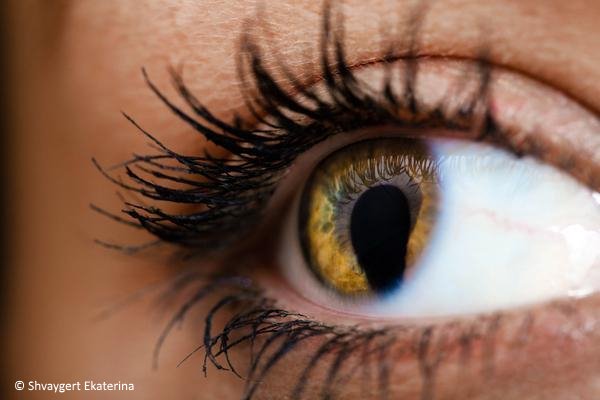Rarest Eye Colors Spotted in Humans

February 20, 2023
•11 min read
Lots of different eye colors exist for a variety of reasons. Let's take a look at some of the rarest eye colors spotted in humans.
They say the eyes are the windows to the soul, but just how special are yours? You’re probably familiar with the same old shades but believe it or not there are people with silver, violet or even multicolored eyes out there. Let's explore some of the rarest eye colors in the world.
10. Ice Blue
You probably know at least one person with blue eyes, but as it stands only about 8-10% of the world’s population can say they have a pair of blue blinkers. In fact, a study conducted by the University of Copenhagen in 2008 revealed that all blue-eyed people are descendants of the first light-eyed human who emerged in South Eastern Europe around 10,000 years ago.
Eye color is determined by the amount of melanin in your iris, which is made up of the epithelium (the back of the iris) and the stroma, which is positioned in front.

9. Amber
79% of us have brown eyes, but there is one rare variation which only 5% are lucky enough to possess, known as amber eyes. People with truly ‘amber’ eyes have a distinctly golden iris which can range from a strong yellow hue to a coppery russet tint, giving someone a seriously penetrating gaze.
This unique coloring is a result of reduced melanin levels alongside the increased presence of a yellowish pigment called lipochrome or pheomelanin. Once again, the interference of light also has a lot to do with the way we perceive amber eyes through the process of Rayleigh scattering, which determines the way we see colors based on how light is reflected. In some conditions, amber eyes might seem closer to brown or hazel, but under natural lighting, there is no mistaking their almost mythical golden glow. This rare variation is sometimes also referred to as ‘wolf eyes’ because such a vibrant coppery tint can also be commonly found in wolves, as well as animals like eagles, owls and fish.8. Green
Green eyes are probably one of the first that comes to mind when you’re asked to list some of the most common colors humans can have, but people with genuinely green eyes only make up about 2% of the planet.
It’s easy to confuse green eyes with hazel which, while still very rare ,contain distinct flecks of brown due to a concentration of melanin on the outside of the iris, making them seem almost multicolored.Truly green eyes lack this characteristic burst of brown or gold radiating outwards from around the pupil, and instead have a more solid emerald shimmer which couldn’t be mistaken for blue or brown.Much like blue eyes, a natural green pigment doesn’t actually exist in humans, so what we see is created by a process called ‘structural colouring’. In this case, the iris has low levels of melanin alongside a small amount of yellow pheomelanin, meaning that when Rayleigh light scattering gives off a blue hue this mixes with the pheomelanin to create green.
7. Silver
Claiming to have silver eyes might arise suspicions that you’ve inherited some supernatural genes, but about 1% of people out there do in fact have gray eyes.
An individual with these mysterious peepers can have an iris which ranges from cold steel to a smokier blue hue, but contrary to popular belief having gray eyes isn’t just a more creative way to describe a considerably pale blue shade.Although significantly low melanin levels are again responsible for the translucent appearance of the stroma, the iris does not reflect blue light due to a certain amount of excess collagen. The presence of this collagen interferes with the way light reflects in the iris, and the appearance of blue hues through the Tyndall effect is therefore blocked, presenting a more solid gray color instead.
6. Black
Your pupil, which is essentially a hole located within the iris, appears black because light rays entering it are absorbed by tissues inside the eyeball, but is it possible to be born with completely black eyes?


5. Violet
You might have heard of the popular internet myth about a genetic mutation called ‘Alexandria’s Genesis’ which supposedly causes purple eyes during puberty, while others might feel nostalgic over Actress Elizabeth Taylor’s famous violet eyes – but is there any truth behind this sought-after color?
Distichiasis & Hypertrichosis are 2 conditions that Elizabeth Taylor was born with. Distichiasis is when someone has an extra row of eyelashes & Hypertrichosis is when you’re born w/a thick layer of black hair covering your body. Both are extremely rare. @twistedhistory

4. Red
For centuries humans have associated red eyes with all things evil, and although we’re used to seeing red eyes in flash photography, having crimson-hued peepers is nothing but a work of fiction. Or, is it?
3. Different Colored Eyes
Although a tiny portion of the world’s population does have totally unique eye colors, most of us will have brown or blue eyes. But there are some lucky individuals who ended up with one of each! This mind-blowing phenomenon is known as ‘heterochromia iridum’ and it occurs in less than 1% of the world's population.
While incredibly rare, the unusual condition can be traced back to ancient times, and there’s even a record of an Eastern Emperor ‘Anastasius’ who was nicknamed ‘Dicorus’ which literally means “two-pupiled” because he had different colored eyes; one blue, and one brown.2. Multicolored Eyes
If there’s anything cooler than having two different colored eyes, it’s mixing those colors into one. This unbelievable variation is another strain of heterochromia iridum known as ‘sectoral heterochromia’ and it’s just as rare. In fact, you’d be lucky to encounter someone with this unique condition in your lifetime.
In these unusual cases, the distribution of melanin across a single iris is distinctly non-uniform, which means that light is both absorbed and scattered from different areas of the stroma at once. This mostly manifests itself as a characteristic splash of brown or blue which stands out against the dominant shade, but occasionally a near 50/50 distribution can result in a breath-taking iris which is split down the middle.1. Cat Eyes
Regular humans with catlike eyes may seem like a plot for the most boring superhero movie ever made, but believe it or not, there is one extremely rare condition which can make someone’s eyes seem totally non-human.
Cat eye syndrome affects one in around 100,000 births and is commonly caused by a chromosome abnormality known as an inverted duplicated 22.This means that each cell has at least one extra chromosome made up of genetic material from chromosome 22, which leads to the characteristic signs of cat eye syndrome, the most visible being a distinctly elongated pupil much like a feline or reptile.This defect is scientifically known as an ‘iris coloboma’ which is basically a hole in the structure of the eye present during the early stages of prenatal development that fails to close. The often keyhole-shaped pupil can seem like it’s melting into the iris, making the color of the eye itself seem swirled or spotted from a distance.Eye defects such as cat eye syndrome are often caused by optic cup malformation during development. Catch up on the latest study revealing just how diverse the underlying mechanisms are ow.ly/8RwQ30nKXgy #OpenBiology

I hope you were amazed at these rarest eye colors spotted in humans. Thanks for reading!






















](https://beamazed.b-cdn.net/dfhvoxjgb/image/upload/v1716778294/craziest-soviet-machines-you-wont-believe-exist/3707x14JJW0KoGxAHLS3gL.jpg?width=400)






